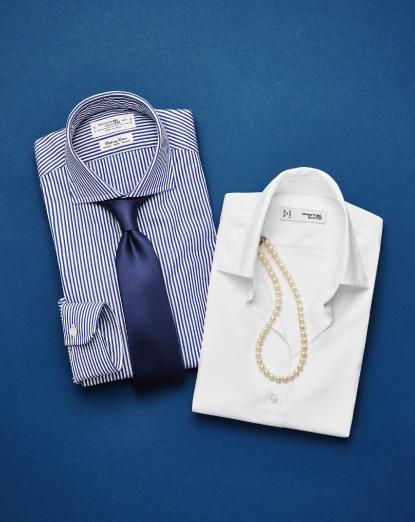
In 1993, we opened a small shirt store in Kamakura, a historic city located to the south of Tokyo. Since the very beginning, everything we do has been for our customers. We have put every effort into producing shirts that are true to the expectations of “Made in Japan.” Our highly efficient business model means that we are able to offer high quality products at an affordable price.
We believe that the finest quality products, together with the spirit of selfless hospitality – both seen and unseen – are paramount in bringing the greatest satisfaction to our customers.
Yoshio Sadasue Tamiko Sadasue
私たち夫妻は、1993年、東京から離れた古い歴史の街、鎌倉で小さなシャツストアを始めました。
すべてはお客様のためにと誓い、メードインジャパンに恥じないシャツ作りを一生懸命に続けて参りました。上質で納得価格はローコスト経営に徹して実現することができました。
上質、目に見えるおもてなしと目に見えないおもてなし。
このサービスとの両輪がお客様にとっての最高の喜びと感動につながるものと考えています。
貞末 良雄 貞末 タミ子
How the business began
Inspired by Kensuke Ishizu, founder of VAN Jacket Inc.
創業のきっかけ ヴァンヂャケット創業者、石津先生からの一言
“Is there no one to take over my vision and make Japanese men fashionable?”
Those words began it all.
These were the words of Kensuke Ishizu, founder of the VAN Jacket clothing company (VAN Jacket Inc.). Yoshio and Tamiko Sadasue both worked for VAN Jacket, the company responsible for introducing American Ivy League fashion to Japan in the 1960s and 70s. Ishizu’s words of woe continued:
“It was my job to establish a clothing company during Japan’s post-war recovery, and to teach Japanese people to dress in a manner that wouldn’t be dismissed in international company. After VAN went bankrupt, men’s fashion in Japan deteriorated significantly. No one has come forward to take over my vision.”
Yoshio Sadasue replied immediately.
“Then I will start a shirt store.”
Sadasue was secretly developing a business plan that focused on customers’ long-term happiness.
「日本人の男性をおしゃれにするという私の意志を引き継いでくれる人はいないのかね」というある人物からの一言が全ての始まりでした。その人物とは、1960年代、70年代にアメリカのアイビーファッションを日本に紹介し、一世を風靡したヴァンヂャケット創業者の石津謙介氏です。貞末夫妻は昔、ヴァンヂャケットで働いていました。石津先生の嘆きはさらに続きます。「日本が戦後復活して行く上で、洋服の会社を作り、日本人が国際社会に打って出て行くときに、見劣りしない服装を教えるのが私の仕事だった。ヴァンが倒産して以降、日本のメンズファッションがダメになった。私の意志を引き継ぐものは出て来ていない」。「それでは、私がシャツ屋をやります」と貞末良雄は即答したのです。
貞末は、長きに渡りお客様に喜んでもらえる事業構想を密かにあたためていました。
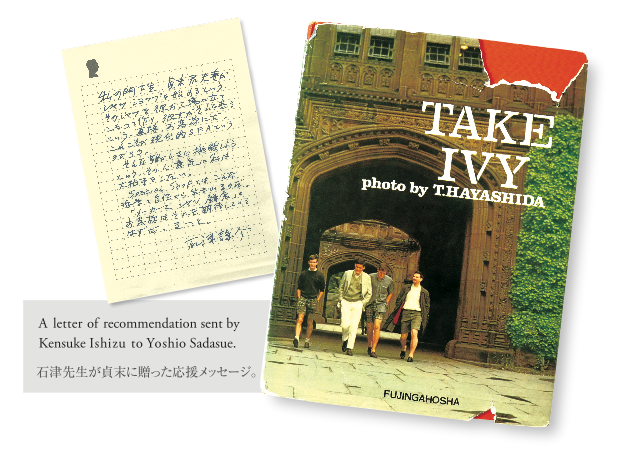
TAKE IVY (1965), a photo book containing photographs that captured the style worn around Ivy League campuses (photographed item belongs to Yoshio Sadasue, originally published by FUJINGAHOSHA). The staff at VAN Jacket spent two weeks on the East Coast shooting photographs on the campuses of Ivy League universities. On the other side of the Pacific, Kensuke Ishizu and VAN Jacket led the movement for Ivy League fashion in Japan. TAKE IVY was reissued in English by powerHouse Books in 2010.
1965年、アメリカのアイビーリーガーを撮影した写真集「TAKE IVY」初版本。(婦人画報社・現ハースト婦人画報社、貞末私物)。ヴァンヂャケットの取材班が2週間かけてアメリカ東部アイビーリーグのキャンパスをまわり撮影。太平洋を超え、石津謙介氏率いるヴァンヂャケットがアイビーファッションを日本で根付かせた。2010年、英語版「TAKE IVY」がpowerHouse Booksより復刻された。
The idea was to start a specialty shirt store that sold high quality products at an appropriate price. This was a completely new take on the retail business models of the past. Shirts are a necessity for men to be fashionable. By providing high quality at an affordable price, Sadasue was certain that customers would welcome this new shirt store. After seeing Sadasue’s determination, Ishizu wrote the following short message of recommendation.
“My finest apprentices, Mr. and Mrs. Sadasue, have told me that they are to open a shirt store. Mr. Sadasue intends to shut himself away in a factory to make the shirts and Mrs. Sadasue will sell them to customers directly. This is truly the modern SPA1. I would like to applaud them for endeavoring on such a difficult task. This is precisely the confidence and philosophy needed to establish a shop that feels special. I am sure that many people have been waiting for a store like Maker’s Shirt Kamakura – most certainly.”
In 1993, Yoshio and Tamiko Sadasue opened their small shirt store above a convenience store in Kamakura with the hope that one day, their shirts and brand would be recognized by everyone, including those at the heart of Ivy League fashion in the sacred grounds of menswear, a place of admiration since the days of VAN Jacket: New York.
それは、上質でありながら納得価格のシャツ専門店。従来のビジネスモデルとは、一線を画した究極の製造小売業です。男性のおしゃれに欠かせないアイテムがシャツ。上質で納得価格のシャツ専門店であれば、品質を見極めるお客様に必ず受け入れられるに違いないという確信がありました。その心意気に石津先生が貞末に贈った手書きの応援メッセージにはこう書かれてあります。
「私の門下生、貞末君夫妻がシャツショップを始めるという。そのシャツを彼が工場に立てこもって作り、彼女がそれを売るという。直接、お客様にだ。これこそが、現代的S.P.Aというのだろう。そんな難しさに挑戦しようという、その心意気に私は大拍手をしたい。SPECIAL SHOPとはこんな哲学と自信から生まれるのだ。“メーカーズシャツ鎌倉” お客様はそれを期待しているはずだ。きっと」
こうして、1993年、夫婦二人三脚で、鎌倉のコンビニエンスストアの2階に小さなシャツ専門店をひっそりとオープンしました。
世界に通用するシャツ。ヴァンヂャケット時代から憧れていたアイビーファッションの本場であり、メンズウェアの聖地、ニューヨーク。いつかは、この地で認められる世界に通用するシャツブランドに育てたいという夢とロマンを抱きながら……。
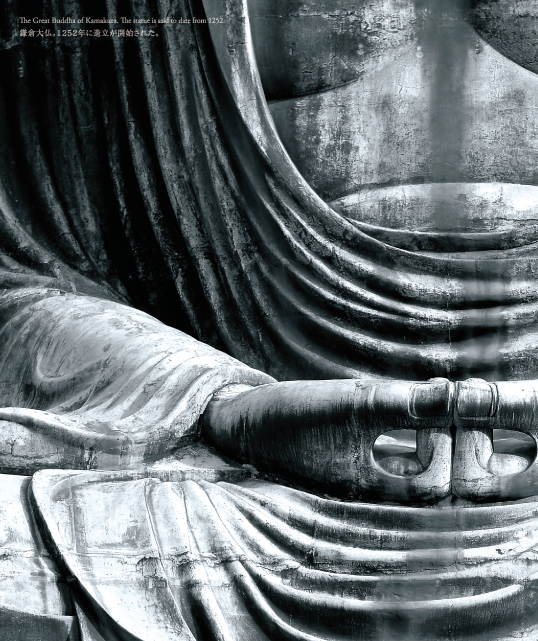
Kamakura,where it all started
A fascinating city that was once the ancient capital for samurai
発祥の地 鎌倉 武家の古都、特別で魅力的な街
Kamakura, where it all began, was also where President Tamiko Sadasue was born and raised. The reason for the use of “Kamakura” in the brand name was because Kamakura itself has special connotations. With mountains surrounding the East, North, and West, and Sagami Bay to the South, the area forms a natural fortress. In 1192, the first ever military government led by samurai was established here, using this geographical advantage. As a result, Kamakura became the political and cultural center of Japan. These samurai followed the path of "Zenshu," making Kamakura the birthplace of Zen philosophy. In modern times, a host of writers and luminaries have fallen in love with the city and called it their home. Consequently, many unique trends have emerged out of their presence there.
The city of Kamakura attracts tourists from all over Japan and beyond. Not only can it boast the proud heritage of the ancient samurai, it also has the natural beauty of the ocean and mountains to offer, while remaining easily accessible from Tokyo. It is an honor for Kamakura Shirts to use the name of such an attractive city, and we will continue to nurture our brand to stay true to the prestigious image of “Kamakura.”
ブランド発祥の地、鎌倉は、社長の貞末タミ子が生まれ育った土地です。そして、お店の名前に鎌倉を冠したのは、「鎌倉」自体に特別な響きとイメージがあるからです。鎌倉は、南に海、三方を山に囲まれた自然の要塞。この地の利を活かして、1192年、史上初めての武家政権が誕生し、武家の政治・文化の中心として発展しました。武士たちが帰依したのが禅宗で、禅の発祥地でもあります。近現代には、小説家や要人の住まいや別荘地としても愛され、様々なカルチャーや流行が生まれました。
由緒ある武家の古都としての歴史的背景と風光明媚な自然、東京からのアクセスの良さもあり、日本人だけでなく世界中から多くの外国人が観光に訪れています。この魅力溢れる鎌倉という名前を誇りに思うとともに、鎌倉の名に恥じぬよう、「鎌倉シャツ」をこれからも大切に育んで参ります。
Kamakura City and Kamakura Shirts
By Tamiko Sadasue
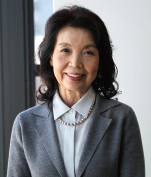 Business often takes me out of Tokyo, and whenever I meet new people, the conversation always goes like this:
Business often takes me out of Tokyo, and whenever I meet new people, the conversation always goes like this:
“Where are you from?”
“Kamakura.”
“That’s such a nice place to live!”
It’s always the same, but it always makes me happy. I was born and raised in Kamakura. Other than five years in Osaka for my husband’s job and then two years in Mishima, Shizuoka, I’ve lived in Kamakura my entire life. So I tend to think living in Kamakura is an obvious thing. But I guess it’s not, and I’ve come to realize that people aspire towards living here.
When we founded the company, my husband (Chairman Yoshio Sadasue) chose the name “Maker’s Shirt,” because we were selling “freshly made” shirts. I thought the name was a little dull. I wanted a more memorable name to launch me back into the working world having been a homemaker for 22 years. I thought it had to be “Maker’s Shirt Kamakura.” Thinking that my husband would object, I anxiously suggested that we add “Kamakura” to his idea. I was surprised that he approved without hesitation: “Let’s do it.” It wasn’t much of a shop – just a rough, little space on the second floor of a convenience store.
Let’s go back to look at Kamakura’s history. Back in 1192, Minamoto no Yoritomo established a national military government in Kamakura. The area
is a natural fortress, difficult for enemies to attack. Mountains surround the East, North, and West, and the South faces Sagami Bay. The Emperor never once lived in Kamakura, giving it a spartan feel. And today there are many shrines and temples from the era that keep the samurai spirit alive. Kamakura is austere and unostentatious and makes the most of the natural environment. That’s a big contrast with Kyoto, where the Emperor lived for generations and has an aristocratic culture; Kyoto’s streets and buildings are colorful and flamboyant, from the Golden Pavilion to the Silver Pavilion.
During the Meiji Period (1868-1912), Kamakura became home to the culturati, including writers Soseki Natsume, Ryunosuke Akutagawa, Doppo Kunikida, Yasunari Kawabata, and Jiro Osaragi. There are many novels that use Kamakura as the backdrop. Both Doppo Kunikida and Masaaki Tachihara wrote novels called Kamakura Madam which were love stories. From these novels, the phrase “Kamakura Madam” took a life of its own. Young people may not know the term, but Kamakura madams were wealthy women, just like “Ashiya madams.” Ashiya, between Osaka and Kobe, is famous as an affluent residential area, so Kamakura was the equivalent for Eastern Japan. Commoners would call the graceful and beautiful matriarchs “Kamakura madams.” This makes me remember that the first time Kamakura Shirts was written up in a magazine, the article title was “The Favorite Store
of Kamakura Madams.”
Then there’s the ocean, which gives Kamakura a strong association with the overall Shonan area. Shonan refers to the beachside towns of Kamakura, Zushi, and Hayama. In the 1950s, Shonan became famous as the haunt of youth called the Sun Tribe (Taiyozoku). This all started when Shonan-based novelist Shintaro Ishihara – who later became the governor of Tokyo – wrote a book about local teenagers called Season of the Sun. The book won him the esteemed Akutagawa literary prize at age 23, and after the media attention, teens out on the Shonan beach became known as the Sun Tribe. They wore sunglasses and flamboyant beach clothes, and liked to play around. Even though Japan was not as developed as it is now, the Sun Tribe sat under parasols on the beach listening and dancing to American songs on their transistor radios. I was a very young girl at the time but intrigued by the Sun Tribe. I almost felt like they weren’t Japanese. Even though I watched them from far away, the memories are still vivid. Those Sun Tribe teens must now be in their 80s... Since that time, Shonan has been at the cutting-edge of trends.
At the end of the 1960s, Shonan became home to Japan’s first surfers. Teenagers in beach style who surfed became known as “Shonan Boys.” They were stylish young men from good families who grew up in the area. “Kamakura Madams” and “Shonan Boys” are both very charming names.
Since the Meiji Period, many of the country’s top luminaries have had their vacation homes in Kamakura, and since it’s just an hour from Tokyo on the Yokosuka Line, there are many executives, writers, and actors who commute every day on the train’s first-class Green Car. And because it’s a city with so much history, Kamakura sees tourists year round from northern Hokkaido to southern Kyushu. It has always been a popular destination for tourists from abroad as well.
With the backdrop of history, the natural scenery of ocean and mountains, and residential areas close to Tokyo – there is no other city in Japan like Kamakura. There is nothing that makes us happier than the fact that we have been able to identify our brand with the image of Kamakura, a charming city known all over Japan.
At some point, people in Japan just started calling us “Kamakura Shirts,” and today we’re better known as “Kamakura Shirts” than “Maker’s Shirt Kamakura.” So when we opened in New York, we decided to call the brand “Kamakura Shirts.” It makes sense: our company was born and bred in Kamakura, and our flagship shop is still in Kamakura, right next to the famous Tsurugaoka Hachimangu shrine.
It is an honor to wear the name Kamakura and be called Kamakura Shirts. We will continue to do our best to live up to that name.
Translated by W. David Marx.
W. David Marx is a writer based in Tokyo, founder and editor of néojaponisme.com. His first book is Ametora: How Japan Saved American Style — a cultural history of Japanese menswear.
Kamakura City and Kamakura Shirts
By Tamiko Sadasue
私は仕事でよく地方に出張し、たくさんの人に出会う機会がある。「どこからいらっしゃいましたか?」「鎌倉です」「まあ、いいところにお住まいですね!」と、決まって言われる。そのたびに何だか嬉しくなる。私は鎌倉で生まれ鎌倉で育った。途中、夫の仕事の関係で大阪に5年、静岡県三島に2年住んだが、人生の大半を鎌倉で過ごしている。だから鎌倉に住んでいることが当たり前と思いがちなのだが、そうでもなくてそれは、人々の羨望の的であることに気づかされる。
創業のとき、店の名前は夫の名づけた「メーカーズシャツ」と決まっていた。作りたてのシャツを売るという意味だ。でもそれではつまらない。22年間専業主婦だった私が社会に再デビューするのだもの、もっと印象的な名前をつけたいと思った。「メーカーズシャツ鎌倉」以外にないと思った。夫が反対するのではと恐る恐る「メーカーズシャツ」の後に「鎌倉」を付け足したいと言った。すると意外にも「じゃあ、そうしよう」と。お世辞にも素敵な店とは言えない、近所のコンビニエンスストア2Fの目立たなくて小さい粗末な店の名前は、こうして簡単に決まった。
1192年、源頼朝が鎌倉に幕府を開いた。鎌倉は東、北、西の三方を山に囲まれ、南は相模湾に面しているので敵が攻めにくく自然の要塞になっているためだ。鎌倉には一度も天皇がお住まいになったことがなく、この時代に建立されたたくさんの神社仏閣は武士の精神が生かされ質実剛健というか、自然を大切にしたので地味で質素だ。それに反して、京都は、代々天皇がいらして公卿の文化であったため、金閣寺や銀閣寺を始めとする京都の街並みや建物は、きらびやかで華やかだ。
そして、そんな鎌倉には明治時代から鎌倉文士と言われた夏目漱石、芥川龍之介、国木田独歩、川端康成、大仏次郎などキラ星の如く、たくさんの小説家が住んでいた。鎌倉を題材にした小説も多数ある。
国木田独歩と立原正秋(この人も鎌倉)のこの二人は各々、同じ題名の「鎌倉夫人」という小説を書いている。内容は恋愛を描いたものだが「鎌倉夫人」という名が独り歩きした。若い人は知らない呼び名と思うが昔は「鎌倉夫人」「芦屋婦人」と、よく並び称されたものだ。関西の芦屋は高級住宅街として有名だが、東のそれは鎌倉であるという事か。庶民は、楚々として美しい和服姿の裕福な奥様を「鎌倉夫人」と呼んだそうだ。ちなみに鎌倉シャツが、創業時に初めて雑誌に掲載されたタイトルは「鎌倉マダム御用達の店」だった。時が経ち、「鎌倉夫人」は「鎌倉マダム」へと変貌を遂げた。
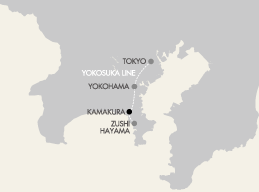 また、鎌倉は海があるということで湘南というイメージがある。昔は湘南といえば鎌倉、逗子、葉山この地域一帯のことをいっていた。50年代に「太陽族」が湘南の浜辺に出没した。太陽族とは、湘南住まいの石原慎太郎(元都知事)さんが、当時の若者の生活を題材にして、23歳で芥川賞を受賞した「太陽の季節」という小説から影響を受けた、若者のことを言う。彼らはサングラスに派手なカッコして遊び回っていた。まだ日本が今のように発展していなかった時代に、太陽族は浜辺のビーチパラソルの下で、トランジスタラジオから流れるアメリカの曲に合わせ歌い踊っていたものだ。まだ幼い少女だった私は興味深々、何だか日本人ではないような気がして、遠くから見ていたことを今でも鮮やかに覚えている。湘南はこの頃から流行の最先端を行っていたのだと思う。
また、鎌倉は海があるということで湘南というイメージがある。昔は湘南といえば鎌倉、逗子、葉山この地域一帯のことをいっていた。50年代に「太陽族」が湘南の浜辺に出没した。太陽族とは、湘南住まいの石原慎太郎(元都知事)さんが、当時の若者の生活を題材にして、23歳で芥川賞を受賞した「太陽の季節」という小説から影響を受けた、若者のことを言う。彼らはサングラスに派手なカッコして遊び回っていた。まだ日本が今のように発展していなかった時代に、太陽族は浜辺のビーチパラソルの下で、トランジスタラジオから流れるアメリカの曲に合わせ歌い踊っていたものだ。まだ幼い少女だった私は興味深々、何だか日本人ではないような気がして、遠くから見ていたことを今でも鮮やかに覚えている。湘南はこの頃から流行の最先端を行っていたのだと思う。
太陽族と呼ばれたこの人たちは、今はもう80歳くらいですね・・・。
そして、60年代終わりごろ、日本で初めてサーフィンが湘南の海に登場した。たくさんの湘南ボーイがマリンスタイルでサーフィンをした。湘南出身で、育ちがよくておしゃれな若者を「湘南ボーイ」と人々は言った。鎌倉マダムに湘南ボーイ、誰がつけたか、なかなかチャーミングなネーミングですね。
明治時代から要人の別荘がたくさんあった鎌倉は、今では横須賀線で東京まで1時間で行けるので、グリーン車で都内に通うエグゼクティブや小説家、俳優がたくさん住んでいる。そして歴史ある街の常として、北は北海道から南は九州まで、一年中、観光客が絶えることがない。最近では外国人も増えた。
多くの歴史的背景と、海や山の自然がたくさんあり、住宅地としても東京に割合近い鎌倉のような街は、日本中探してもないと思う。この日本中の誰もが知っている魅力的な鎌倉のイメージと私たちを重ね合わせて下さっているとしたら…こんな嬉しいことはありません。
いつの頃からか、私たちが知らないうちに「鎌倉シャツ」と、呼ばれるようになっていた。今ではもしかしたら「メーカーズシャツ鎌倉」より「鎌倉シャツ」の方が、多くの方に知られているかもしれない。そういうわけでニューヨーク店は「Kamakura Shirts」と名づけた。鶴岡八幡宮という鎌倉のシンボルのそばにあるメーカーズシャツ鎌倉本店、私たちは鎌倉で産声を上げ、鎌倉に育てられた。
鎌倉という名前を冠して「鎌倉シャツ」と呼ばれることは、この上なく有難く光栄なことと思います。鎌倉の名に恥じぬようこれからも一生懸命、励んで参ります。
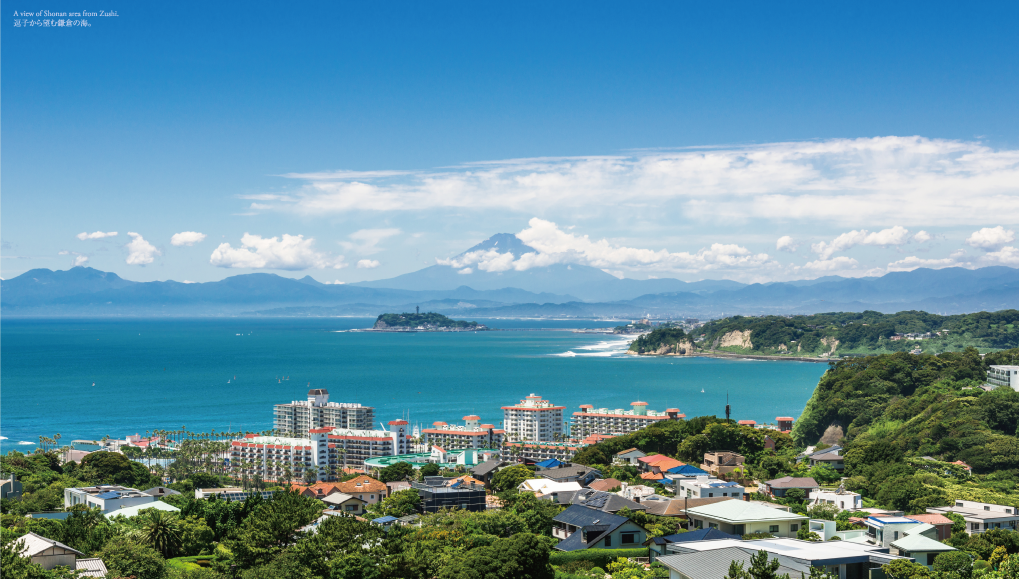
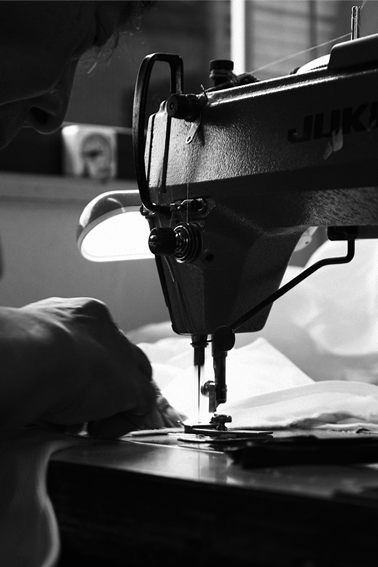
Made in Japan
Dealing directly with an entirely Japanese manufacturing team
メードインジャパン 縫製工場と直接取引、オールジャパン体制で結集
From the very start, Kamakura Shirts have been committed to ensuring the quality of the materials used, as well as maintaining high standards of manufacturing by using Japanese sewing factories.
The sewing techniques used in Japan are said to be the highest in the world due to precise craftsmanship and excellent skill. With the motto, “each stitch placed with the greatest care,” each garment is delicately sewn together. The shirts are finished with single needle seams that look neat even on the inside, and the shirt pattern itself is elegantly curved to fit around your body. Most of the fabrics we use are 100% cotton and reach a yarn count of 100. For some of our collections we use luxurious 200 and 300 count cotton. The buttons are made from natural shells, and the interlinings we use are non-fused. Just putting your arm through one of the sleeves will soon make you realize why these shirts are so special.
We work very closely with the Japanese factories and deal with them directly, cutting out the middlemen. We research and develop new ideas together with the factories, and place an emphasis on all-Japanese manufacturing. These factories work as a team, not as rivals, and keep techniques open in order to promote better craftsmanship between them. Keeping the entire production process in Japan facilitates communication between all parties involved, and both maker and seller can unite for a common goal.
Through direct communication and the elimination of the middleman, we can cut costs substantially. As well as the aforementioned sewing factories, we deal directly with fabric mills and subsidiary material makers too, all for the goal of producing high quality shirts that can be sold at an affordable price.
The Kamakura Shirts brand cannot grow without the outstanding sewing factories that support us. We will continue to put our heart into producing every one of our shirts, in Japan.
創業時から、高品質な素材を使い、縫製など製造工程の全てをメードインジャパンで貫いてきました。
日本のシャツ縫製技術は細やかな職人技と卓越した技術力によって、世界最高レベルと言われています。「一針入魂」をモットーに、一針一針、丁寧に縫い上げています。
裏から見ても縫い目が美しく肌触りがよい「巻き伏せ本縫い」、体のラインにフィットするパターン曲線。生地は、主に綿100%の100番手素材を中心に、200番手、300番手などの最高級素材も使用しています。ボタンは、天然の貝を使用し、芯地には、フラシ芯を採用。袖に腕を通せばその違いをすぐにわかっていただけるでしょう。
全ての国内協力縫製工場とは、直接取引し、共に研究開発を重ね、オールジャパン体制で結集しています。縫製工場同士が技術を共有し、品質統一と更なる向上を目指しています。国内だからこそ、コミュニケーションが円滑にとれ、作り手と売り手が一心同体となれるのです。
そして、縫製工場をはじめ生地メーカーや副資材メーカーと直接取引することにより、中間コストを大幅に削減し、「上質で納得価格」を実現しました。ブランドの発展は縫製工場とともにあります。オールジャパン体制で、情緒豊かなシャツを、ひとつひとつ心を込めて作っています。
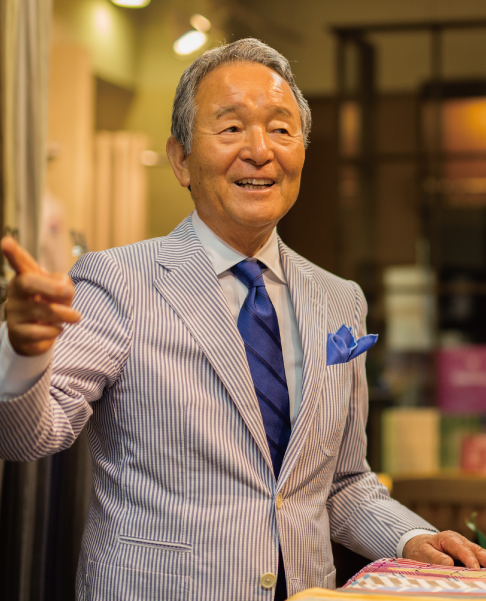
Sincerity
From father to son – a lesson in how to be a true merchant
誠実さ 父親から受け継いだ「商人道」〜 商いへの高い志〜
There are over 5,000 companies in the world that are more than 200 years old. Of those companies, over half are located in Japan. This commercial heritage reflects Japan’s culture of putting the customer before profit, and the desire to succeed the accomplishments of past generations. The idea of “sincerity” is very important in Japan.
The Sadasue family were mercers as far back as the Edo period (17th to 19th century). From a young age, Yoshio was taught the principles of trade and the art of being a true merchant by his father:
“Merchants have always been seen as having low social standing. That is why it was important for them to value dignity and pride even more than high-ranked samurai. A merchant receives his share only once the customer is happy. A true merchant will not lie. He works hard for others, sells what he has gathered and lives on the reward of pleasing someone. Therefore, have the same, if not more dignity and pride than the samurai, and follow the path of a true merchant.”
What Yoshio’s father taught was not merely a business model but a “mind model.” His experience taught him the importance of having high aspirations, even as a merchant.
Yoshio and Kamakura Shirts inherited the wisdom of fair play from Yoshio’s father, committed to producing and selling shirts with the deepest sincerity. We are devoted to maintaining a business that can be trusted, and dedicated to providing observable high quality in our products together with the intangible Japanese spirit of hospitality in our service. It is for the same reason that Kamakura Shirts have never held discount sales: we set an honest price for our customers from the beginning. How are customers to trust us if we are selling something at half the price it was yesterday? Through constant efforts to achieve a low-cost business model, we have been able to set a fair price for customers from the very start. This is precisely the honest merchant’s way that we have always desired.
世界中には、創業200年以上の企業が
5000社以上ありますが、その半数以上が日本に集中しています。目先の利益を追わずお客様第一主義で、代々受け継いでいく精神性が日本人にはあるのでしょう。それは日本人の「誠実さ」に起因しているのかもしれません。
貞末家は江戸時代から続く呉服商で、貞末良雄は、父親から商いの正道すなわち「商人道」を教わって育ちました。
「昔から商人の地位は低かった。だから武士以上に品格や誇りを大切にしなければならない。商人とは、お客さんに喜んでもらって初めて、その分け前をいただけるんだ。本当の商人というのは嘘はつかない。人のために身を粉にして働いて、自分が調達したものを売って喜んでいただいて生計をたてるものである。武士以上に強い品格と矜持をもって商人道を貫け」。商人としての生き方を導いた父親の教えは、ビジネスモデルというよりマインドモデルで、商いへの高い志でした。
父親直伝の商人道を受け継ぎ、フェアプレイの精神で「誠実にシャツを作り、誠実に売る」という信頼の商いを心がけてきました。心の礼節を持って、見える品質と見えざるサービスでお客様をおもてなしすることを信条としています。創業以来、セールをしないのも、お客様に誠実でありたいから。昨日まで売っていた値段が翌日、半値というのは、お客様との信頼を損ねてしまうことではないでしょうか。たゆまぬ企業努力とローコスト経営により、はじめからお求めやすいセール価格を設定することは、私たちが追求する商人道なのです。
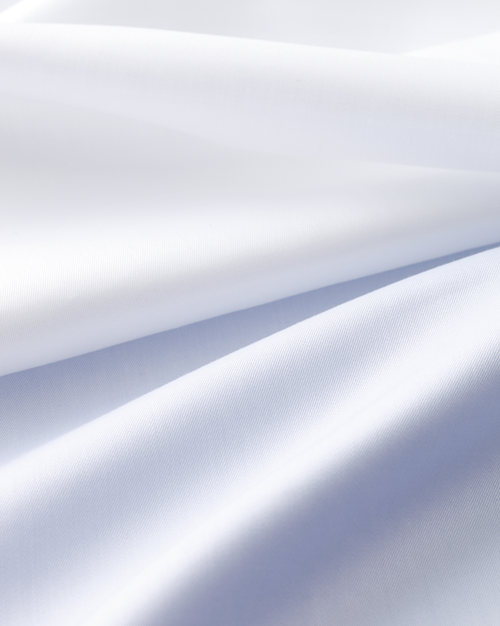
Evolution and innovation
Putting our customers first
進化・革新 - すべてはお客様のために
People’s tastes are always evolving. For that reason, we must provide our customers with even better shirts and service that surpasses expectations. With that in mind, we have searched for superior fabrics, improved sewing techniques, and revised shirt patterns; we are constantly seeking innovation in both quality and design. We have put in place a remarkable form of merchandising so that we can hear people say, “I didn’t know that amazing quality shirts could be this affordable.” Whatever the age, we maintain a global perspective and keep our senses alert so that we can always realize “outstanding merchandising” for our customers.
Since ancient times, Japanese art and culture has enshrined meticulous attention to detail, and the spirit of sparing no efforts for self-improvement. It is rooted in our culture to follow traditions while still adapting to the times when it comes to manufacturing.
The cultural shift from the traditional kimono to wearing and manufacturing Western-style clothing such as shirts has been a challenge. That in particular is why we have put our customers first, and refuse to make any compromises in researching what makes our customers happy. Our challenge to evolve and tirelessly improve ourselves will continue, so that we can provide customers with even better products and services.
人々の嗜好は常に進化します。ですから、私たちは、お客様に、より良いシャツ、期待以上のサービスを心がけています。そのために、さらに上質な生地の調達、縫製の仕方、パターンのあり方など品質とデザインの向上を目指し、「この値段で、こんなに良いシャツが買えるのか」と驚いていただけるよう努力してきました。
いつの時代も、世界的な視点を持ち、フレッシュな感性で、お客様のために「驚愕のマーチャンダイジング」を実現することが私たちにとっての進化であり革新です。
幸いにも、日本人は、古来から、細かなことに気を配り、さらに改善して行くことに努力を惜しまない特性を持っています。伝統を受け継ぎながら時代に合わせて進化させるモノ作りのDNAがずっと続いてきました。
とはいえ、長年、着物文化だった私たちは、欧米の洋服文化であるシャツ作りの歴史は浅く、まだまだ未熟と考えています。だからこそ、お客様に寄り添いながら、謙虚に、真の洋服を研究し、お客様に喜んでいただけるアイテムやサービスをご提供できるよう、さらなる進化・革新に挑戦し続けます。




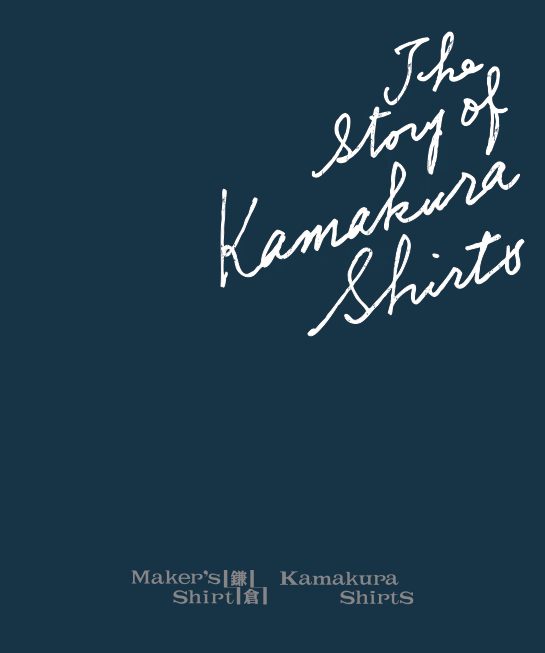

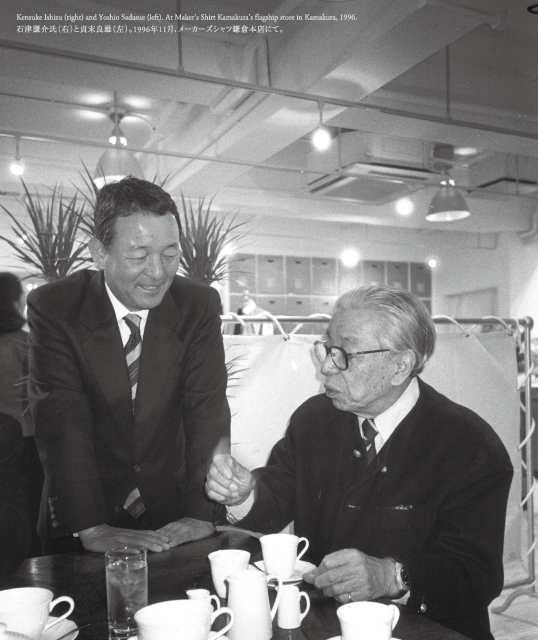

 Business often takes me out of Tokyo, and whenever I meet new people, the conversation always goes like this:
Business often takes me out of Tokyo, and whenever I meet new people, the conversation always goes like this: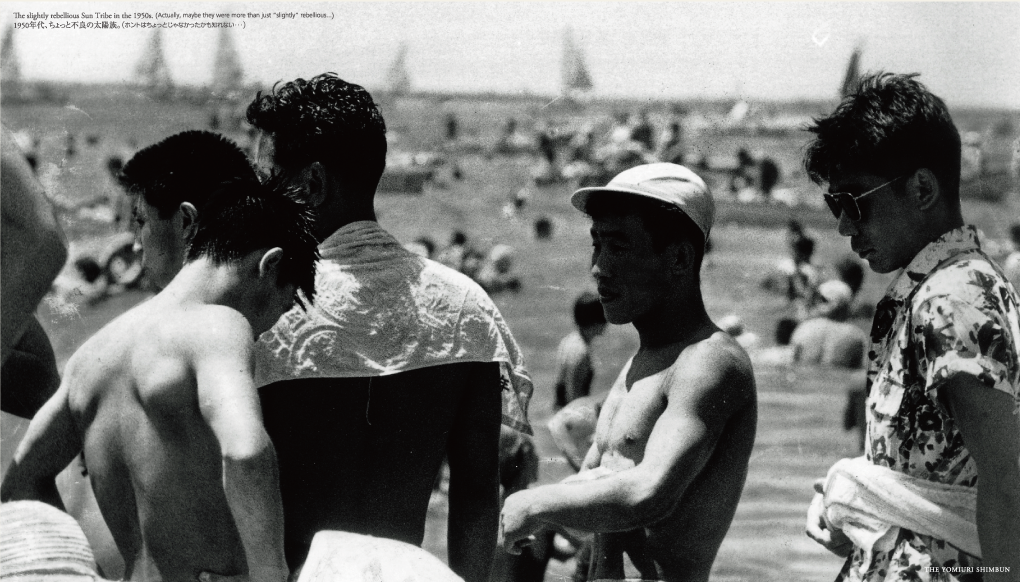
 また、鎌倉は海があるということで湘南というイメージがある。昔は湘南といえば鎌倉、逗子、葉山この地域一帯のことをいっていた。50年代に「太陽族」が湘南の浜辺に出没した。太陽族とは、湘南住まいの石原慎太郎(元都知事)さんが、当時の若者の生活を題材にして、23歳で芥川賞を受賞した「太陽の季節」という小説から影響を受けた、若者のことを言う。彼らはサングラスに派手なカッコして遊び回っていた。まだ日本が今のように発展していなかった時代に、太陽族は浜辺のビーチパラソルの下で、トランジスタラジオから流れるアメリカの曲に合わせ歌い踊っていたものだ。まだ幼い少女だった私は興味深々、何だか日本人ではないような気がして、遠くから見ていたことを今でも鮮やかに覚えている。湘南はこの頃から流行の最先端を行っていたのだと思う。
また、鎌倉は海があるということで湘南というイメージがある。昔は湘南といえば鎌倉、逗子、葉山この地域一帯のことをいっていた。50年代に「太陽族」が湘南の浜辺に出没した。太陽族とは、湘南住まいの石原慎太郎(元都知事)さんが、当時の若者の生活を題材にして、23歳で芥川賞を受賞した「太陽の季節」という小説から影響を受けた、若者のことを言う。彼らはサングラスに派手なカッコして遊び回っていた。まだ日本が今のように発展していなかった時代に、太陽族は浜辺のビーチパラソルの下で、トランジスタラジオから流れるアメリカの曲に合わせ歌い踊っていたものだ。まだ幼い少女だった私は興味深々、何だか日本人ではないような気がして、遠くから見ていたことを今でも鮮やかに覚えている。湘南はこの頃から流行の最先端を行っていたのだと思う。


